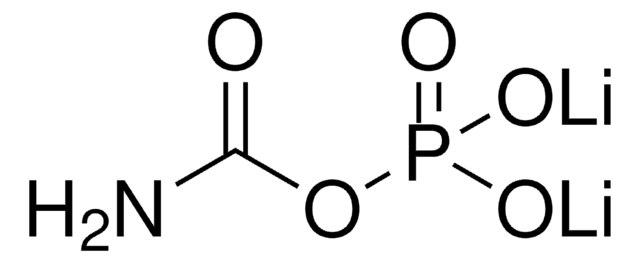A0262
Lithium potassium acetyl phosphate
≥85% (elemental analysis), powder
Synonym(s):
Acetyl phosphate lithium potassium salt
About This Item
Recommended Products
product name
Lithium potassium acetyl phosphate, high-energy phosphate donor
Assay
≥85% (elemental analysis)
form
powder
mp
>300 °C (lit.)
solubility
water: 25 mg/mL, clear, colorless
storage temp.
−20°C
SMILES string
[Li+].[K+].CC(=O)OP([O-])([O-])=O
InChI
1S/C2H5O5P.K.Li/c1-2(3)7-8(4,5)6;;/h1H3,(H2,4,5,6);;/q;2*+1/p-2
InChI key
RLQMPLKXFIXRCV-UHFFFAOYSA-L
Looking for similar products? Visit Product Comparison Guide
Related Categories
Application
- has been used as a substrate for CpxR (transcription factor) in x-ray crystallography to soak CpxR receiver domain (CpxRRD) crystals to obtain the phosphorylated form
- may be used as a phosphate (P) donor in a study to screen a wide range of natural and synthetic organic phosphate donors with several enzymes on various hydroxyl?compounds for the improved enzymatic synthesis of phosphate monoesters
- has been used to set up premixA for in vitro translation reaction
Biochem/physiol Actions
Signal Word
Danger
Hazard Statements
Precautionary Statements
Hazard Classifications
Eye Dam. 1 - Repr. 2 - Skin Corr. 1B
Storage Class Code
8B - Non-combustible corrosive hazardous materials
WGK
WGK 3
Flash Point(F)
Not applicable
Flash Point(C)
Not applicable
Personal Protective Equipment
Certificates of Analysis (COA)
Search for Certificates of Analysis (COA) by entering the products Lot/Batch Number. Lot and Batch Numbers can be found on a product’s label following the words ‘Lot’ or ‘Batch’.
Already Own This Product?
Find documentation for the products that you have recently purchased in the Document Library.
Customers Also Viewed
Our team of scientists has experience in all areas of research including Life Science, Material Science, Chemical Synthesis, Chromatography, Analytical and many others.
Contact Technical Service













